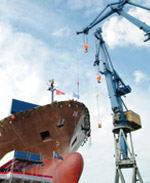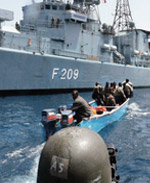- Maritime highways of global trade
- > The volume of maritime traffic increased significantly over recent decades, but the global economic crisis brought the industry to its knees. Now there are promising signals for a recovery, however, nobody knows what the future holds for the process of globalization, the global imbalances still linger on and the world of finance continues to be in a fragile state. The growing threats of piracy and terrorism could also compromise shipping.

A look at the future
The recent global economic crisis precipitated a sharp slump in world shipping. Yet the global economy rebounded in 2010. Global trade, in decline until the spring of 2009, has increased markedly since the summer of that year. On the other hand, the economic situation will continue to be depressed for some time yet. From a global perspective, Germany’s major economic think tanks state in their autumn 2010 outlook that the 1 per cent decline in world production in 2009 is likely to be followed by an increase of 3.7 per cent in 2010 (2011: 2.8 per cent), driven mainly by rapid recovery in a number of newly industrializing economies and in China and several western European nations. World trade fell sharply by 11.3 per cent in 2009 but will grow about 12 per cent in 2010 (2011: 6.8 per cent). This has bolstered demand for transport somewhat. It remains to be seen whether market globalization will continue as before or will change tack. Fears that the financial crisis could compromise the international division of labour and thus world trade and shipping are not yet fully dispelled. The container success story came to an abrupt end in 2008 with the slump of the global economy. A. P. Moller-Mærsk A/S, owners of the largest container fleet in the world, estimate that container handling fell by 10 per cent in 2009 – the first decline since containers were introduced on global shipping routes in the 1970s! Following its many years of success, container shipping will also come under pressure from forthcoming fleet expansions. A great number of extremely large ships will be completed in the near future, which will have a negative impact on the recovery of freight rates. The extent to which climate change will affect shipping is difficult to foresee. Extreme weather conditions such as gales could impair transport and navigation conditions, increase the risk to ships and cargo and complicate loading and unloading operations. Sea freight transport, the world’s most important medium of transportation, could become more expensive. On the other hand, if the Arctic polar ice cap melts new shipping routes could open up, providing considerable savings in time and energy. It is conceivable, for instance, that the Northwest Passage and the Northern Sea Route could be open to shipping for several weeks or even for months each year (Chapter 1).

